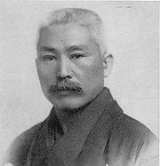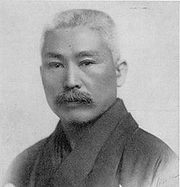
Uchida Ryogoro
Encyclopedia
Uchida Ryōgorō Shigeyoshi (written as Ryōgorō Uchida in the west), (1837 - October 22, 1921), was a Japanese
jojutsu practitioner, ranked menkyo in the Japanese martial art of Shintō Musō-ryū
(SMR). He is the creator of the gendai budo
Uchida Ryu Tanjojutsu
, originally known as Sutteki jutsu or "stick method".
Uchida Ryōgorō Shigeyoshi was born as Hiraoka Ryōgorō in 1837 to father Hiraoka Nisaburo. He was the eldest of six children. After Ryōgorōs 14th birthday he was adopted into the Uchida family and took on the Uchida family name. He was adopted due to a lack of an heir to the Uchida fmaily name.
Ryōgorōs biological father held a License of Total Transmission (Menkyo) of the Haruyoshi-branch of the "The "New Just" Muso-ryu tradition". From an early age Ryōgorō showed an aptitude for martial arts and excelled in his studies. He trained in all of the arts a bushi (warrior) was expected to learn which included horsemanship, bowmanship, gunnery, swordmanship, spear and a multitude of other weapons and skills. Among the arts he learned was Ono-ha Itto-ryu swordsmanship from Ikuoka Heitaro, the art of spear from a retainer of the Takeda family, Kyushin-ryu jujutsu from exponent named Ishikawa and Shinto Muso-ryu Jo from Hirano Kichizo Yoshinobu of the Haruyoshi-branch. Ryōgorō is said to have received the scroll of complete transmission from each of the mentioned ryu.
 Sometime after the Seinan war
Sometime after the Seinan war
of 1877, Ryōgorō moved to Tokyo
and started teaching SMR, though in a smaller scale than his future successor Shimizu Takaji. Two of his known students were Ryōhei Uchida
(his son) and Nakayama Hakudo
(the founder of Muso Shinden-ryu
iaido and a master of kendo
). Ryōgorō created a set of tanjo kata
based on the teachings of SMR and influenced by the walking sticks gentleman of the era carried, which he called "Sutekki" (the Japanese way to pronounce "stick"). After his death, the set of kata were named Uchida Ryu
in his honor and are now practiced as one of the heiden bujutsu of Shintō Musō-ryū.
Japanese people
The are an ethnic group originating in the Japanese archipelago and are the predominant ethnic group of Japan. Worldwide, approximately 130 million people are of Japanese descent; of these, approximately 127 million are residents of Japan. People of Japanese ancestry who live in other countries...
jojutsu practitioner, ranked menkyo in the Japanese martial art of Shintō Musō-ryū
Shinto Muso-ryu
, most commonly known by its practice of jōdō, is a traditional school of the Japanese martial art of jōjutsu, or the art of wielding the short staff . The technical purpose of the art is to learn how to defeat a swordsman in combat using the jō, with an emphasis on proper combative distance,...
(SMR). He is the creator of the gendai budo
Gendai Budo
, meaning "modern martial way", are modern Japanese martial arts which were established after the Meiji Restoration . Koryū are the opposite: ancient martial arts established before the Meiji Restoration.-Scope and tradition:...
Uchida Ryu Tanjojutsu
Uchida Ryu Tanjojutsu
, also known as Sutekki-Jutsu, is a Japanese martial arts school of tanjojutsu, originally devised by Shinto Muso-ryu practicitioner Uchida Ryogoro as a way to utilize the western-style walking stick into a weapon of self-defence...
, originally known as Sutteki jutsu or "stick method".
Uchida Ryōgorō Shigeyoshi was born as Hiraoka Ryōgorō in 1837 to father Hiraoka Nisaburo. He was the eldest of six children. After Ryōgorōs 14th birthday he was adopted into the Uchida family and took on the Uchida family name. He was adopted due to a lack of an heir to the Uchida fmaily name.
Ryōgorōs biological father held a License of Total Transmission (Menkyo) of the Haruyoshi-branch of the "The "New Just" Muso-ryu tradition". From an early age Ryōgorō showed an aptitude for martial arts and excelled in his studies. He trained in all of the arts a bushi (warrior) was expected to learn which included horsemanship, bowmanship, gunnery, swordmanship, spear and a multitude of other weapons and skills. Among the arts he learned was Ono-ha Itto-ryu swordsmanship from Ikuoka Heitaro, the art of spear from a retainer of the Takeda family, Kyushin-ryu jujutsu from exponent named Ishikawa and Shinto Muso-ryu Jo from Hirano Kichizo Yoshinobu of the Haruyoshi-branch. Ryōgorō is said to have received the scroll of complete transmission from each of the mentioned ryu.

Satsuma Rebellion
The was a revolt of Satsuma ex-samurai against the Meiji government from January 29 to September 24, 1877, 9 years into the Meiji Era. It was the last, and the most serious, of a series of armed uprisings against the new government.-Background:...
of 1877, Ryōgorō moved to Tokyo
Tokyo
, ; officially , is one of the 47 prefectures of Japan. Tokyo is the capital of Japan, the center of the Greater Tokyo Area, and the largest metropolitan area of Japan. It is the seat of the Japanese government and the Imperial Palace, and the home of the Japanese Imperial Family...
and started teaching SMR, though in a smaller scale than his future successor Shimizu Takaji. Two of his known students were Ryōhei Uchida
Ryohei Uchida
was a Japanese ultranationalist political theorist. Pan-Asianist, and martial artist, active in the pre-war Empire of Japan.-Biography:Uchida was born in Fukuoka prefecture. He was the son of Shinto Muso-ryu practitioner Uchida Ryōgorō, and from an early age was interested in many forms of Japanese...
(his son) and Nakayama Hakudo
Nakayama Hakudo
, also known as Nakayama Hiromichi, was a Japanese martial artist and founder of the iaidō style Musō Shinden-ryū. He is the only person to have received both jūdan and hanshi ranks in kendō, iaidō, and jōdō from the All Japan Kendo Federation...
(the founder of Muso Shinden-ryu
Muso Shinden-ryu
is a iaijutsu koryū founded by Nakayama Hakudō , last sōke of the Shimomura branch of Hasegawa Eishin-ryū. The term "iaidō" appeared in 1932 and was popularized by Nakayama Hakudō .-Particularities:...
iaido and a master of kendo
Kendo
, meaning "Way of The Sword", is a modern Japanese martial art of sword-fighting based on traditional Japanese swordsmanship, or kenjutsu.Kendo is a physically and mentally challenging activity that combines strong martial arts values with sport-like physical elements.-Practitioners:Practitioners...
). Ryōgorō created a set of tanjo kata
Kata
is a Japanese word describing detailed choreographed patterns of movements practised either solo or in pairs. The term form is used for the corresponding concept in non-Japanese martial arts in general....
based on the teachings of SMR and influenced by the walking sticks gentleman of the era carried, which he called "Sutekki" (the Japanese way to pronounce "stick"). After his death, the set of kata were named Uchida Ryu
Uchida Ryu Tanjojutsu
, also known as Sutekki-Jutsu, is a Japanese martial arts school of tanjojutsu, originally devised by Shinto Muso-ryu practicitioner Uchida Ryogoro as a way to utilize the western-style walking stick into a weapon of self-defence...
in his honor and are now practiced as one of the heiden bujutsu of Shintō Musō-ryū.

